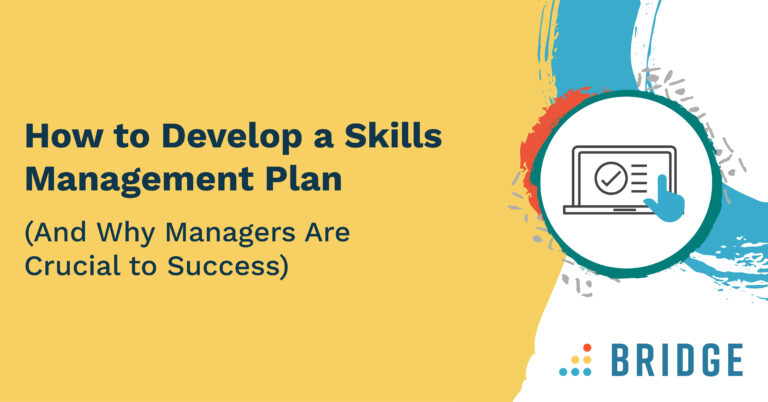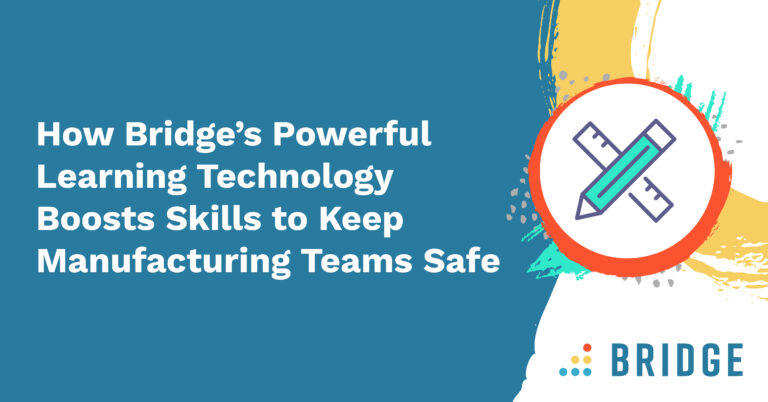The 2020s have become the decade of employee development. That’s according to a report from the World Economic Forum, which points out that:
- We’ll see disruptions to 44% of workers’ skills over the next five years
- Six in 10 staff members will require training before 2027
As you might imagine, the best way to meet this challenge is via upskilling—but what does that look like in practice? Recognizing the need for an upskilled workforce is a great start, but you can’t just let your people loose in a library of eLearning content and hope for the best!
Instead, you need to start looking at upskilling like the precise and targeted process that it is. That means identifying the skills your organization needs, cross-referencing them against the skills your people already have, and enlisting managers to help your people fill those gaps via the right learning materials.
In other words: you need a skills management plan.
Read on to discover what skills management is, understand the tools you’ll need to make it work, and enjoy a step-by-step overview of what a skills management plan might look like in action.
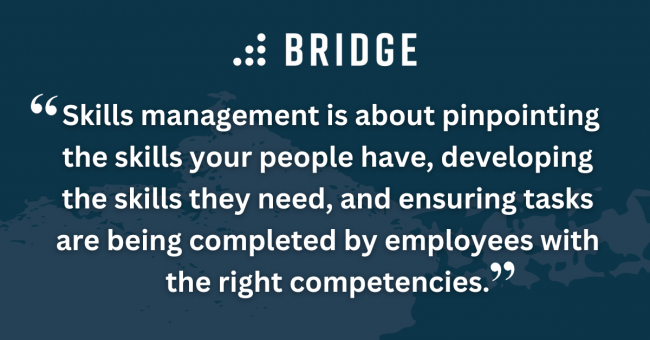
What Is Skills Management?
Your people all bring different skills to the table—but do those skills match up with the competencies their job roles demand?
Skills management is about pinpointing the skills your people have, developing the skills they need, and ensuring tasks are being completed by employees with the right competencies.
When skills management is done well, you’ll find yourself able to swiftly close any skills gaps as they arise, whether that’s by reallocating employees with the skills you need, or by developing new skills in line with evolving competency expectations.
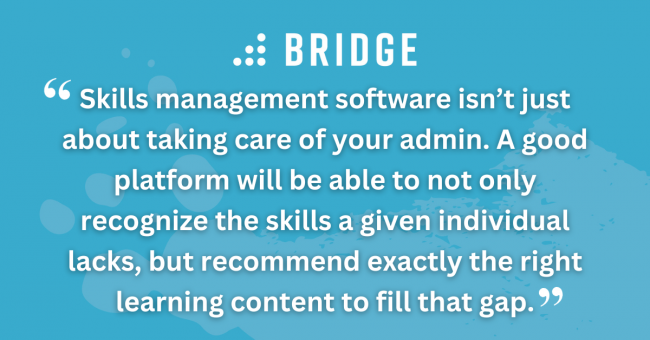
The Best Skills Management Software Has These Key Features
Skills management is a multi-faceted process. It involves administrative elements, like mapping out your organization’s skills needs and tagging learning courses with the skills they teach. But it’s also highly strategic—it’s about knowing what to do with skills data and how to upskill your people in the most effective ways.
The right technology will help you take care of both.
A learning management system with upskilling capabilities might, for example, be able to automatically identify the skills requirements for each employee’s role, removing a huge amount of administrative effort. Better still, if your platform is plugged into the latest skills data, it’ll be just as easy to update. That’s important: an outdated skills map isn’t much good to anyone!
But skills management software isn’t just about taking care of your admin. A good platform will be able to not only recognize the skills a given individual lacks, but recommend exactly the right learning content to fill that gap. This isn’t the be-all and end-all of your skills management process, but it significantly streamlines the strategic thinking you’ll need in order to supercharge your competency levels.
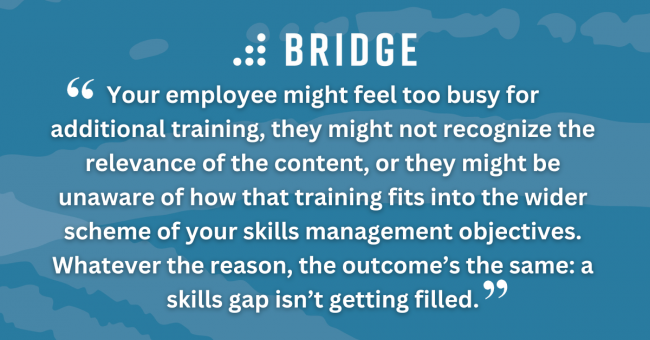
Here’s How People Managers Impact Skills Management
Having the right technology is essential. In fact, despite widespread skills gaps and struggles to fill key roles, only 20% of organizations use upskilling software—which explains why skills gaps are still so prevalent! But tech is only part of the story: it’s equally about securing manager buy-in to the skills management process.
Let’s say your upskilling platform recommends a training course to one of your employees: it’s a relevant course that’ll help close gaps in the employee’s knowledge. That’s a great start, and it means your platform has dealt with a huge swathe of admin, from automatically tagging the course to assessing the missing skills in your employee’s repertoire. But that doesn’t mean your employee is actually going to do the course!
There are plenty of possible reasons for this. Your employee might feel too busy for additional training, they might not recognize the relevance of the content, or they might be unaware of how that training fits into your wider skills management objectives. Whatever the reason, the outcome’s the same: a skills gap isn’t getting filled.
That’s where your managers come in. A good manager will monitor skills needs and motivate upskilling by:
- Sanctioning any time spent on recommended training
- Explaining how a given course relates to individual upskilling requirements
- Articulating the value of upskilling by placing specific needs and recommendations in context
Motivation is key, but managers are more than the cheerleaders of your skills management process. They have control over how their reports are shared and deployed. With managers’ help, you’ll be able to move employees across your organization to the areas their skillsets will see the most use: a potent addition to your skills gap-closing toolkit.
If you want to empower your managers to make the biggest impact on skills management, you’ll want to insert them into a formalized process. But what do these skills management plans look like? Let’s take a look.
RELATED READING | ‘How HR Can Help Managers With Talent Development’
Skills Management Planning in Action
Like any process, your skills management efforts will be improved when they’re formalized into a plan. While these plans will vary depending on your organization’s circumstances, we’ve put together a five-step example that will set you up to supercharge your skillsets.
1) Work Out Your Skills Requirements
Each role within your organization requires a variety of different skills. These skills will vary from one industry to the next, and they’ll likely change in line with new technologies and evolving practices.
The best way to get a handle on your skills needs is to invest in the right tech. An LMS with AI upskilling features will draw from the latest skills data to determine exactly what kind of competencies each employee requires—and that information will inform how your skills management process proceeds.
2) Create A Skills Matrix
Once you understand the skills your people need, you can map those skills onto a skills matrix. This is a simple chart with two axes: one containing employee names, and the other containing the skills they need for a given role, project, team, or department.
Once you’ve got your skills matrix set up, you’re in a prime position to visualize which people need upskilling (and the exact skills they need to develop). At this stage, you’re not just identifying skills gaps: you’re already on the road to closing them.
MORE FROM THE BLOG | ‘Skills Mapping 101: How to Visualize Employee Capabilities’
3) Assign Targeted Training
One of the most direct ways to address your skills gaps is through relevant, targeted training. And, with the right technology, you might find this step is taken care of for you.
An AI-powered LMS with upskilling capabilities will automatically tag learning courses with the skills they teach and recommend them to the learners who need those skills.
KEEP READING | ‘3 Ways Bridge Can Help You Achieve Your Training Goals’
4) Enlist People Managers
Automation is a fantastic time-saver, but automated recommendations are more effective when they’re combined with the encouragement of people leaders. Enlist your managers to monitor upskilling progress through feedback and 1:1 conversations, help keep your learners motivated, and facilitate other upskilling activities like short-term projects.
5) Leverage Employee Competencies
Closing skills gaps isn’t just about growing new competencies, but about making sure the right people are assigned the right tasks. With the help of your managers, make sure your workers are being deployed to the areas or projects where their skillsets will have the most impact.
Streamline Skills Management With Bridge
Bridge’s AI upskilling capabilities shine a light on the competencies that count, keeping your people up to date on the skills that matter most—and your organization free from the inefficiencies that come hand in hand with skills gaps. Request a demo to experience Bridge’s skills features for yourself.
